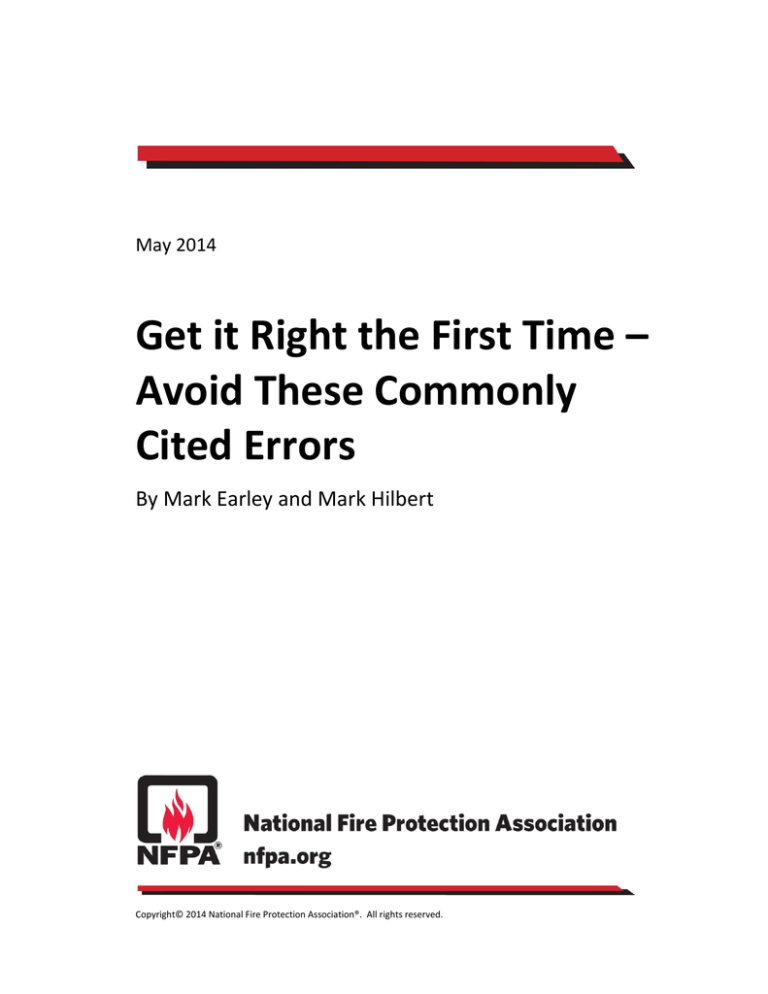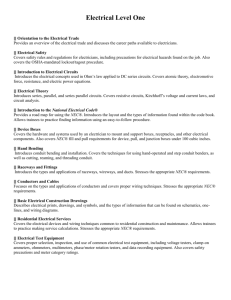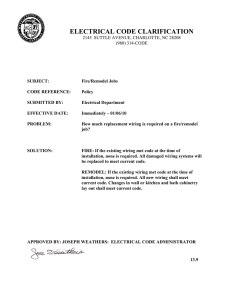
May 2014
Get it Right the First Time –
Avoid These Commonly
Cited Errors
By Mark Earley and Mark Hilbert
Copyright© 2014 National Fire Protection Association®. All rights reserved.
Good electrical contractors understand the value of electrical inspections performed by qualified
inspectors. Problems identified during the inspection of an electrical installation not only help ensure
that public safety is maintained but can help a contractor to avoid the problem in the future. Electrical
inspectors are a great resource for electrical contractors to help them correctly apply National Electrical
Code® (NEC®) requirements and get the job done right … the first time.
Recognizing that informed electricians is a means to the desired goal of safe electrical installations, the
State of New Hampshire Electricians Licensing Board asked its inspectors to compile a list of the
installation problems that they most frequently encountered. This effort began nearly 15 years ago as
the state moved forward with adoption of the 1999 NEC. In order to renew electricians’ licenses, New
Hampshire has required 15 hours of continuing education on a triennial basis since 1984. To augment
their classroom discussion of the changes in each newly adopted NEC, the list of installation problems is
distributed to the providers of continuing education. This “awareness” training has proven to be an
extremely successful tool in achieving code compliance. Reducing compliance problems benefits
everyone and fulfills the safety mission of the NEC. The list is periodically updated, distributed to
continuing education providers, and disseminated in the required continuing education programs. This
paper focuses on some of the items contained in the current New Hampshire list.
Listed Products [110.3(B)]
Manufacturers design products to be installed in a certain environment and used in accordance with a
specific need. Most electrical products are listed by independent laboratories for installation in
accordance with their intended use. Listed products are tested and evaluated in accordance with
applicable product standards. The evaluation criteria may vary based on how and where the product will
be used. A product could be intended for a very high or very low temperature application. It could be
designed for use where it is subject to vibration or to mechanical damage. It might be designed to be
installed outdoors. Yet, often, some installers will use products in environments that were never
intended by the manufacturer. Some of these unintended methods can result in dangerous installations.
Section 110.3(B) of the NEC requires that listed or labeled products be installed in accordance with any
instructions included in their listing or labeling. This makes compliance with those restrictions part of the
requirements of the NEC.
Use limitations for listed products are usually included in the instructions that are provided with the
product. Other information may be published in the listing directory published by the testing laboratory.
For example, UL publishes the White Book — Guide Information for Electrical Equipment, which provides
information on the parameters that may limit how a product can be installed or used in the field. Key
information provided in the directory includes any specific marking that is used to identify specific
product features that affect how the product may be used.
Despite the efforts to make sure that installers are aware of these product restrictions, Section 110.3(B)
is an often violated requirement of the NEC. Common examples cited by the state include the use of
2
expansion fitting in runs of PVC conduit and the tightening of electrical connections. Often, expansion
joints are omitted entirely, which can result in cracking of the conduit and the fittings. Where expansion
fittings are installed, they might be secured at the wrong end. It is intended that they be installed at the
fixed (bell) end. In vertical installations, the expanding end of the fitting should be installed below the
fixed end.
Electrical Connections [110.3(B) and 110.14]
Proper tightening of electrical connections is important to ensure a good low-resistance connection.
Loose connections lead to arcing and pitting of contacts. This can lead to overheating, which can cause a
fire. Loose connections will often become looser due to mechanical vibration. Loose connections
become a more critical problem in circuits with higher loads. Simple screw driver or wrench tight
connections may be insufficient.
Some terminations require that screws be torqued with the proper tool. Torque requirements, where
needed, are often provided in the product manufacturer’s installation instructions. Annex I was added
to the 2011 edition of the code to provide needed torque information to users in the field. This annex is
based on the requirements in UL 486A-B, Wire Connectors.
Spaces around Electrical Equipment [110.26]
Requirements for space around electrical equipment continue to be overlooked or misinterpreted.
There are two basic types of space: equipment space and working space. The equipment space is not
only the space occupied by the equipment; it can also extend up to six feet over the equipment or to the
structural ceiling, whichever is less. This space is needed for proper operation of the equipment and
subsequent maintenance of the equipment. Often, the equipment space is violated when ducts or pipes
foreign to the electrical installation are installed in the space. This can make installation of wiring
methods and maintenance of the electrical equipment difficult, and can also make maintenance of the
piping or ductwork difficult. In addition, accidental leaks could damage equipment or endanger workers.
The working space is a three dimensional area that must meet minimum requirements for depth, width,
and height. This is the area occupied by workers while they maintain equipment. The minimum required
dimensions are intended to provide adequate space for the worker to do his or her tasks safely. The
depth of the working space is the space extending outward from the front of the equipment. The depth
is based on the operating voltage to ground and the conditions of the installation. The depth
requirements are found in Table 110.26(A)(1), and the installation conditions are found in the notes to
the table.
The working space must also be sufficiently wide to provide adequate space to work on the equipment.
It must allow the removal of covers and the opening of equipment doors. The width of the required
working space must be 30 inches or the width of the equipment, whichever is greater. If the equipment
is less than 30 inches wide, the 30 inch minimum still applies. Where the equipment is less than 30
inches wide, the equipment does not have to be in the center of the working space. However, in all
cases, the working spaces must allow at least a 90 degree opening of any equipment doors. The
3
minimum height of the working space is 6½ feet or the height of the equipment. This headroom is
intended to permit a worker to escape the area without injuring his or her head.
Without vigilance, electrical equipment rooms will become storage rooms. Storage can be especially
hazardous if it is flammable or combustible. However, it is also a hazard if the equipment room requires
house cleaning before electrical equipment can be returned to service or if a worker is put in danger by
working in an inadequate space that exposes the worker to harm. The code requires that the working
space be kept clear, so that needed workspace is maintained.
Raceway Seals [225.27, 230.8, 300.7 and 300.50(F)]
Raceways can be a path for water and gases to enter equipment. Heating and cooling cycles can cause
condensation inside equipment and raceways. Temperature differentials along a raceway run can also
allow condensation to form in a raceway. Examples of raceways with temperature differentials include
raceways from the exterior wall of a building to the interior, raceways from unheated areas to heated
areas, and underground raceways. Raceways must be sealed if they enter buildings from the exterior of
the building, from underground, and where there are temperature differentials. Underground raceways
can also present another hazard — the entrance of natural gas. If the raceways are not passing through
a hazardous location, sealing of these raceways (in accordance with the applicable code section) should
suffice.
NM Cable Installations [334.10(C) and Article 100 definition of Concealed]
There continue to be improper installations of NM cable in some buildings permitted to be of Types III,
IV, or V construction. The frequently cited problem is the misunderstanding of what is meant by the
term concealed, which is defined in Article 100. The most common violation is an installation of NM
cable in an accessible attic. This is not concealed because it is not “rendered inaccessible by the building
structure or finish.” It is accessible through the scuttle opening.
Vertical Risers [358.30]
Electrical inspectors often cite improper electrical metal tubing (EMT) vertical risers from industrial
machinery and other fixed equipment. There are requirements in Articles 342 and 344 for the proper
installation of vertical risers of up to 20 feet high using intermediate and rigid metal conduit
respectively. Intermediate metal conduit and rigid metal conduit fittings are more robust than EMT
fittings. An EMT vertical riser may not have the mechanical strength to adequately support conductors
any higher than the 10 foot length permitted in 358.10(A).
Circuit Directories [408.4(A)]
Circuit directories can be a valuable tool when trying to troubleshoot field problems. Directory notations
such as “lights and plugs” are not helpful to the next person working on an installation. A circuit must be
identified “as to its clear, evident, and specific purpose or use.” The identification must provide enough
detail that is sufficient to distinguish circuits from one another. It is also important that the directory
does not depend on “transient conditions of occupancy.” An example of a transient condition of
4
occupancy would include identifying a circuit to a bedroom by the name of the occupant. Several
changes of ownership later, the identification can become meaningless.
Wireways [376.22(A)]
Where there are multiple circuits in a wireway, ampacity adjustment (derating) may become necessary.
Section 376.22(A) was revised for the 2014 edition to clarify the derating requirement for wireways.
Derating is necessary for all current-carrying conductors at any cross section of metal wireways having
31 or more conductors. Failure to derate conductors may result in tripping of overcurrent devices, or it
could result in a fire.
Flexible Cord Is not a Wiring Method [400.7 and 400.8]
Flexible cord is not a wiring method. Yet, installations of cords used as a wiring method continue to be
found in electrical installations. An example of a common misapplication is where cords are run through
holes in ceilings to outlet boxes above the ceiling. This is often found in installations of projectors
beneath suspended ceilings in meeting rooms and in installations of luminaires installed below ceilings.
Separation of Emergency System Wiring [700.10]
Emergency system wiring is required to be kept separate from all other wiring. The requirement applies
to all wiring from the source of the emergency system to all emergency system loads. This requirement
is intended to ensure that an impairment that affects the normal system doesn’t also affect the
emergency system. As a practical matter, the normal system wiring must exist with the emergency
system wiring in some enclosures, including transfer switches and disconnecting means. This section
provides the specific permissions where such installations may be required. In addition to the
requirement for separation from normal circuit wiring, the emergency system wiring must be kept
separate from legally required standby system wiring and optional standby system wiring.
Conclusion
Correcting deficiencies costs time and money. Contractors would prefer to have error-free installations.
Error-free installations mean satisfied customers. This information has been well received in New
Hampshire. Hopefully this information will help contractors everywhere to avoid these pitfalls.
5
About the Authors
Mark Earley
Mark serves as Chief Electrical Engineer at NFPA, where his duties also include serving as secretary of
the National Electrical Code Committee, chief editor of the National Electrical Code Handbook, co-editor
for the Handbook on Electrical Safety in the Workplace, and co-author of Electrical Installations in
Hazardous Locations.
Mark Hilbert
Mark is a Senior NFPA Instructor, the current President of the International Association of Electrical
Inspectors (IAEI), the former Chief Electrical Inspector for the State of New Hampshire (retired) and
Chairperson of Code Panel 2 of the National Electrical Code Committee. Mark also represents IAEI as
the Chairperson of the NFPA 79 Committee.
About the National Fire Protection Association (NFPA)
NFPA is a worldwide leader in fire, electrical, building, and life safety. The mission of the international
nonprofit organization founded in 1896 is to reduce the worldwide burden of fire and other hazards on
the quality of life by providing and advocating consensus codes and standards, research, training, and
education. NFPA develops more than 300 codes and standards to minimize the possibility and effects of
fire and other hazards. All NFPA codes and standards can be viewed at no cost at
www.nfpa.org/freeaccess.
6




